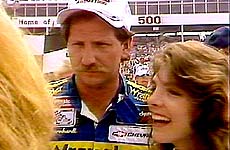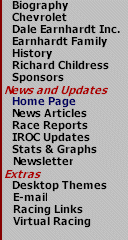 Earnhardt History Earnhardt History
1987 Season
'Top Gun' gets 11 wins and his third
title

 |
1987 Season |
| Starts |
29 |
| Wins |
11 |
| Top 5's |
21 |
| Top 10's |
24 |
| Points Rank |
1 |
|
 |
Crew Chief:
Kirk Shelmerdine |
Car Owner:
Richard Childress |
Car Make:
Chevy Monte Carlo |
| Car No: 3 |
| Sponsor: Wrangler |
|
|
 |
 Richard Childress immediately put to use the $400,000 payoff that Dale
Earnhardt had earned in 1986 for winning the Winston Cup championship. Richard Childress immediately put to use the $400,000 payoff that Dale
Earnhardt had earned in 1986 for winning the Winston Cup championship.
Throughout his career as a driver and owner,
Childress had made a habit of taking enough money out of the pot to support his family and
then plowing the remainder back into his team. In his career as an
"independent" driver, he carefully had plotted his races, trying to finish as
well as possible, and geared his entire effort toward a strong finish in the year-end
standings. The bonus money he won each year from the point fund became his annual
"investment capital" - the money he put back into the team for more parts and
peices, which, hopefully would make his cars run better than the previous season.
 Now that Earnhardt and Wrangler were part of his
team - and his cars were winning - Childress had more money at the end of each season than
he had ever dreamed of during his career as a driver. But his philosophy never
changed. The payoffs had become much larger, but so had the cost of remaining
competitive or gaining an edge on the competition. Annually, he took what his family
needed - and then put the rest of the money back into the team. Now that Earnhardt and Wrangler were part of his
team - and his cars were winning - Childress had more money at the end of each season than
he had ever dreamed of during his career as a driver. But his philosophy never
changed. The payoffs had become much larger, but so had the cost of remaining
competitive or gaining an edge on the competition. Annually, he took what his family
needed - and then put the rest of the money back into the team.
When Earnhardt had returned to the Childress
team, before the start of the 1984 season, the two principals had a long talk with crew
chief Kirk Shelmerdine. What needed to be done to take the Childress team from a
mid-pack runner to the top echelons of the sport and contend for victories race after
race? The answer was a well-planned, methotical approach that would take time to
accomplish, but if followed correctly, would make the team a winner.
 The trio made the decision to tackle the season in segments. With a
third of the races on short tracks and given the team's ability to construct their cars
from the ground up rather than purchase a rolling chassis from other car builders, the
triumvirate decided to try to make the team competitive on the bullrings first, and then
move on to superspeedway cars once the short tracks were conquered. The trio made the decision to tackle the season in segments. With a
third of the races on short tracks and given the team's ability to construct their cars
from the ground up rather than purchase a rolling chassis from other car builders, the
triumvirate decided to try to make the team competitive on the bullrings first, and then
move on to superspeedway cars once the short tracks were conquered.
In 1985, Earnhardt won four times and finished
third twice on the circuit's short tracks. He was at least a contender in all the
other races. Goal number one had been accomplished. The team then turned
to the superspeedways and made steady improvements there as well. Goal number two
was scratched off the list. The team followed the same procedure in 1986 and
accomplished its third and final goal; Dale captured his second career NASCAR Winston Cup
title - the Chuldress team's first.
 With the heady taste of winning the title still on their palates, each man on
the team bent to the new goal for 1987: maintaining Earnhardt's competitive edge and
returning to New York as repeat champions. Fiercely proud of its
accomplishments in 1986, the team refused to sit back on its laurels. Instead, a
grim determination emanated from every member of the crew and the driver as the
blue-and-yellow-clad group opned the season at Daytona. There was a good chance that
Wrangler would be gone at the end of the season, and after the positive things the company
had helped make happen for the team, everyone wanted the sponsor to go out as a
winner. As a result of winning the 1986 championship, Childress had signed an
associate sponsor agreement with GM Goodwrench, the parts and service division of General
Motors. With the heady taste of winning the title still on their palates, each man on
the team bent to the new goal for 1987: maintaining Earnhardt's competitive edge and
returning to New York as repeat champions. Fiercely proud of its
accomplishments in 1986, the team refused to sit back on its laurels. Instead, a
grim determination emanated from every member of the crew and the driver as the
blue-and-yellow-clad group opned the season at Daytona. There was a good chance that
Wrangler would be gone at the end of the season, and after the positive things the company
had helped make happen for the team, everyone wanted the sponsor to go out as a
winner. As a result of winning the 1986 championship, Childress had signed an
associate sponsor agreement with GM Goodwrench, the parts and service division of General
Motors.
As the first eight races of the season went into
the books, Earnhardt left no doubt in his determination to win succesive championships.
Dale ran off wins at Rockingham, Richmond, Darlington, North Wilkesboro, Bristol,
and Martinsville. The only races he didn't win were Daytona nad Atlanta. He
was in his element - trading paint, sheet metal, and bondo, beating and banging on the
short tracks, forcing the blue and yellow Chevrolet into barely existent holes in traffic
and moving other cars to make holes where there had been none. Earnhardt won the
adulation of tens of thousands of fans for his aggressive, "take no prisoners"
style of driving, but not everyone thought his driving was great. Howls of protest
came from car owners, drivers, and crew chiefs as he bullied his way to the point lead.
 During the summer he added Michigan and Pocono to his list of victories, and
by the time the season moved into the stretch run, the point race was all but over.
After winnig at Bristol, his lead was an unbelieveable 545 points over second-place Bill
Elliott. Elliott won the following week, scoring his first victory in the Southern
500 at Darlington. Earnhardt then put an end to any specualtion of who woul win the
championship by scoring his third-straight win and 11th of the season at Richmond, moving
him to a 608-point lead over Elliott. During the summer he added Michigan and Pocono to his list of victories, and
by the time the season moved into the stretch run, the point race was all but over.
After winnig at Bristol, his lead was an unbelieveable 545 points over second-place Bill
Elliott. Elliott won the following week, scoring his first victory in the Southern
500 at Darlington. Earnhardt then put an end to any specualtion of who woul win the
championship by scoring his third-straight win and 11th of the season at Richmond, moving
him to a 608-point lead over Elliott.
With a second place finish at Rockingham,
Earnhardt was able to wrap up the title. It was the earliest s driver had ever
clinched the crown since Cale Yaroughborogh had accomplished it in 1977 (also at
Rockingham).
Truely, in 1987, the others were left to battle
for scraps left by the Childress/Earnhardt combine.



Copyright © 2000 The Earnhardt Connection
Home Page | Contact Us

|


